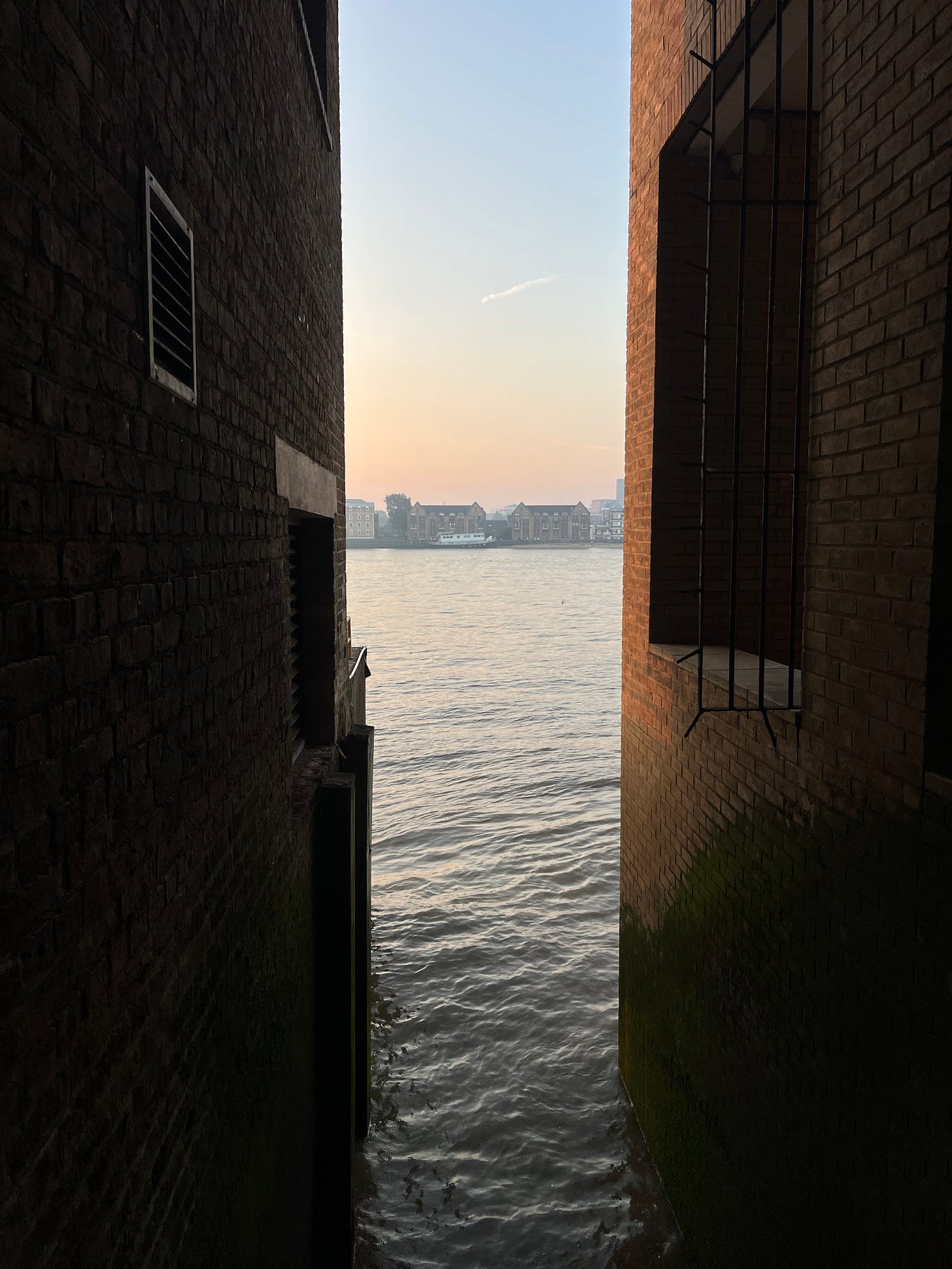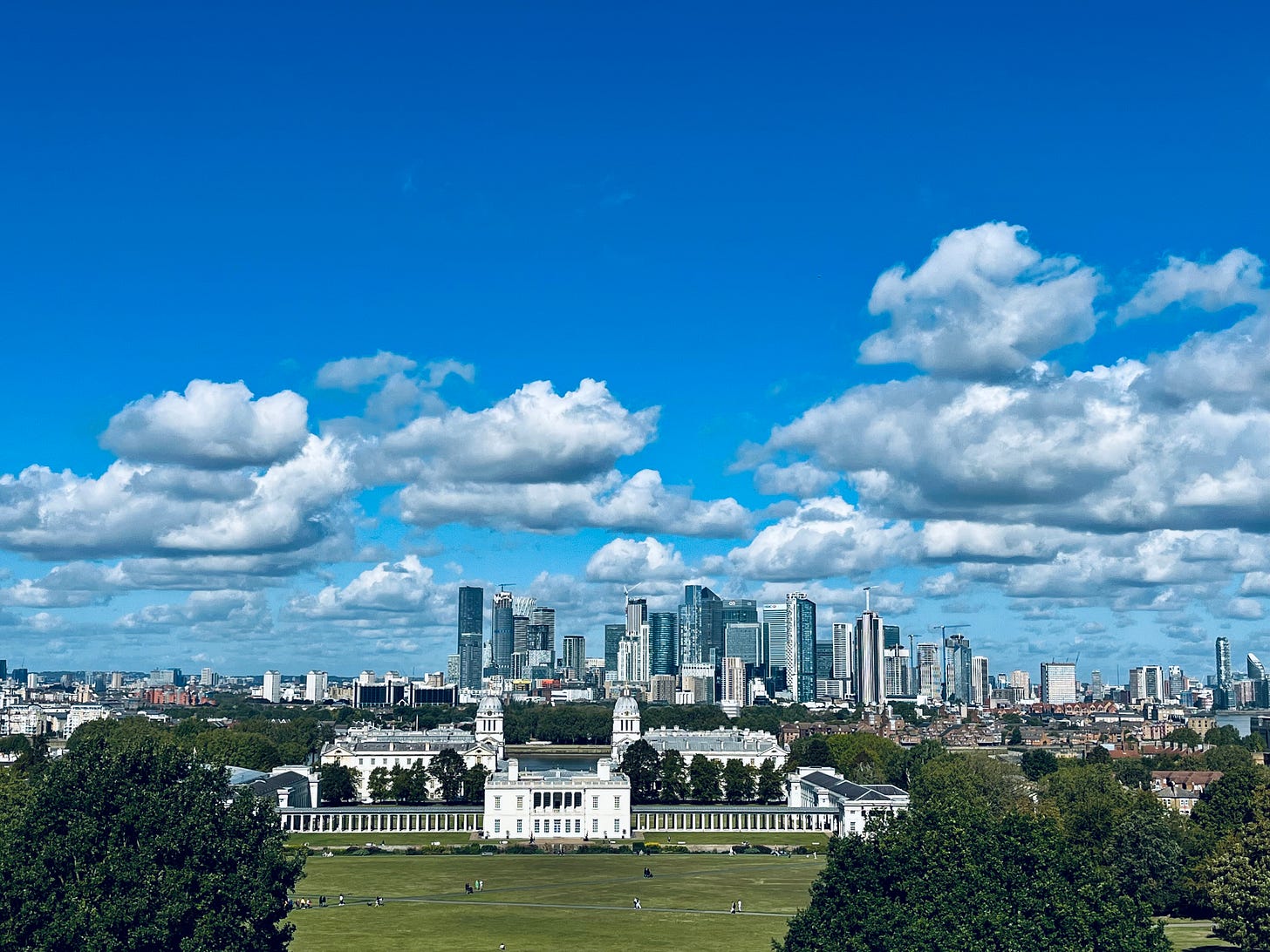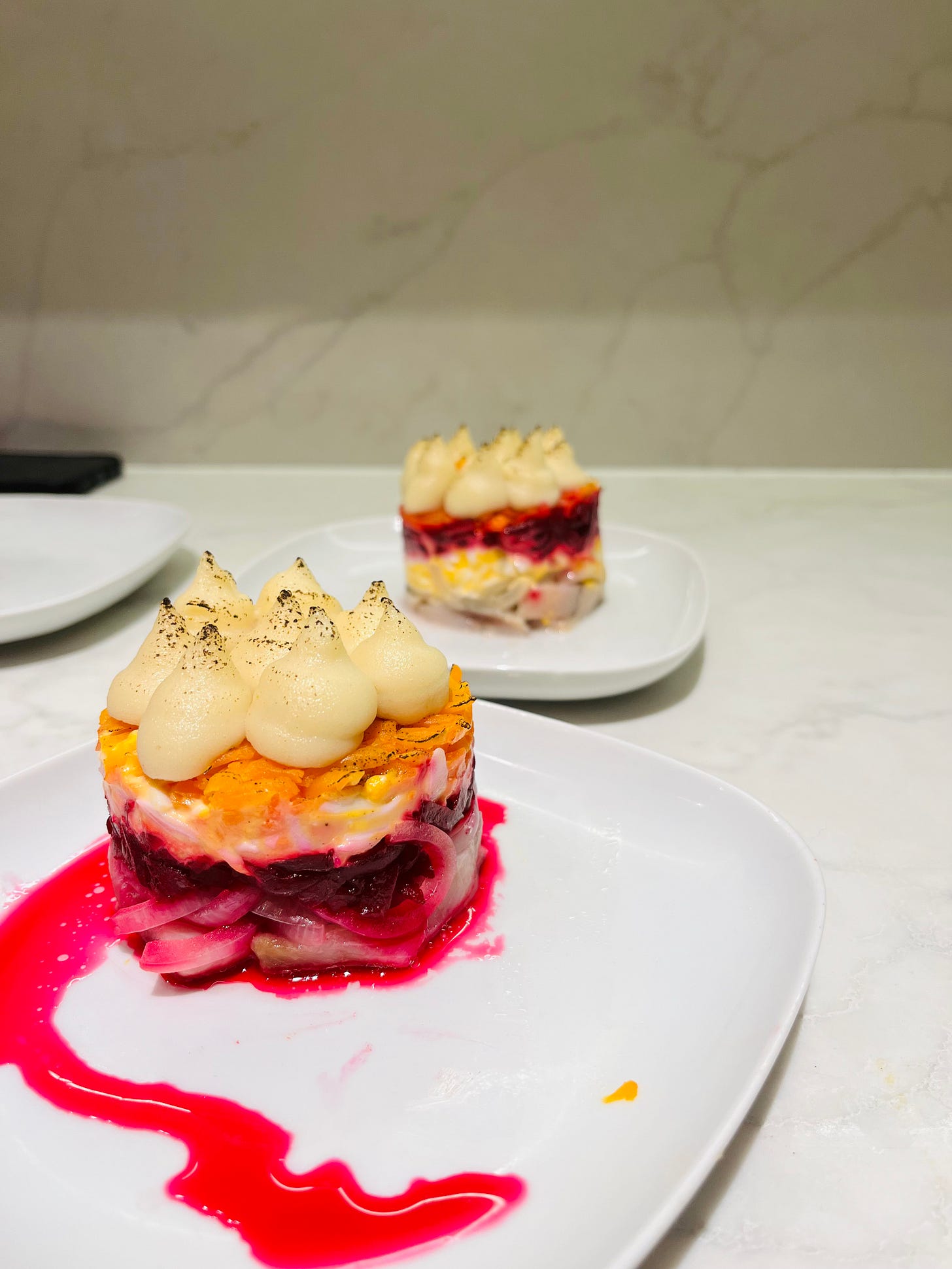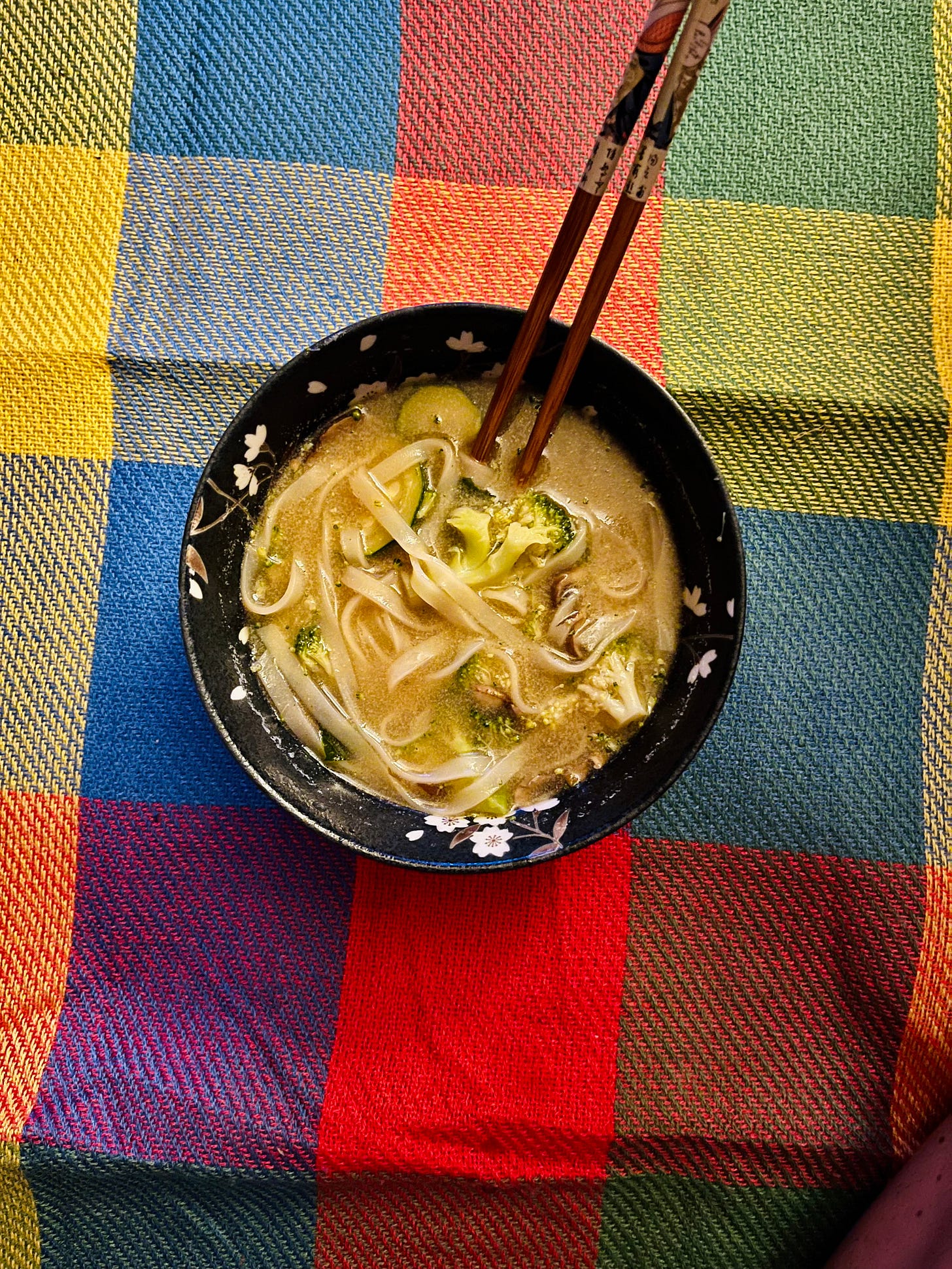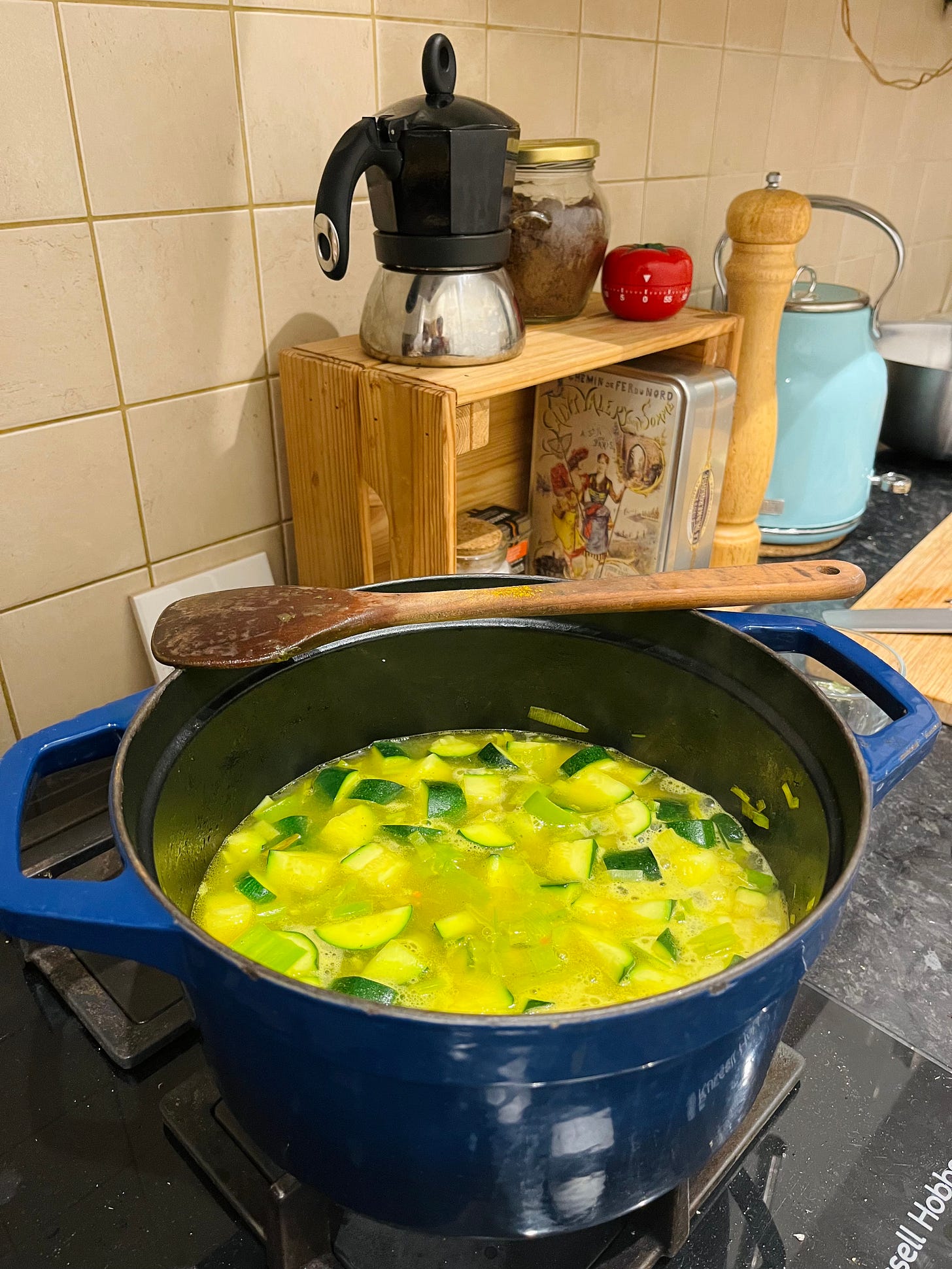The breathing sound of boiling water, followed by the kettle’s on-off switch lifting, an exhale. Pour the water into a casserole, add one celery, halved carrots and onion (unpeeled), vegetables’ peels, parsley stems. Reduce the heat so the soup doesn’t boil, but simmer. Pause.
In September, I live between two places.
I come back to my friend’s flat late at night, drenched, my brain swimming in a fog. We had a glass of wine after dinner with J, to delay the moment we’d have to squeeze and say bye for now. Long enough so she had to jump off the stool and run for her train – no time to think about how to say goodbye. I like it this way, in a thunder, present. So I get to my friend V’s flat, mellow and ready for bed, and I fetch dry clothes in my suitcase. The yellow suitcase I packed three weeks ago and gave to V, so I’d have something to wear while I’m back in London and between two flats, bursts open on the floor with items that are out of season. The sky is low in the morning, yet the temperature is over 20C. 2023 is a stormy September.
I’m looking at the suitcase and I think of my younger self, holding a fluffy pillow with an otter sewed on it in one hand, a bag at my feet, waving at a parent on the platform. I was on my way to visit another parent. The train ticket had a time written on it, beside my seat number, each wall around the station featured a large clock, the adults kept giving me time markers – how long the train journey would be; how much time I’d spend there and there; the waiting time before the train would arrive – not long, as one says to a worried child. I learnt something that day: time is far more than chronological. Time is felt.
***
The last time I was in France, an old friend with whom I have a fragmented but intense relationship gave me a copy of Emmanuel Carrère’s Yoga. The blurb on the back cover reads: January 2015, Emmanuel Carrère joins a meditation retreat. His goal: to write a lovely and short book about yoga. But his project is shaken when he is diagnosed with bipolar II. The book is a compilation of short entries, each mirroring the subjective nature of reality. They are raw and contradictory; honest, tender and vulnerable. Carrère can be witty and pathetic; clairvoyant and tormented. This is a story of a man who wanted to be well and, like any story of wellness, it can’t be linear.
There is a chapter called Fast and Slow, in which Carrère talks about discovering the ‘dojo culture’ at Dr Yang’s annual, week-long seminar. One day, Dr Yang performs a sequence composed of three to four movements that, Carrère tells us, he would realise in one minute if he slowed down. Dr Yang, ‘in a miraculous flow’, prolongs the movement for twenty-five minutes – ‘his body moving like an anemone or a jellyfish’. When he arrives at the end of the sequence, he appears to be immobile, until he teases his audience of practitioners that the best part is still to come. There Carrère asks his reader, in his words, to believe the unbelievable: the doctor goes so fast that he disappears from human eyesight.
There isn’t one version of the time that has gone. Time is active, malleable.
***
It’s Thursday and I’m on my way to Whittington Hospital. I smile at the odd sculpture of a cat in a cage as I turn onto Magdala Avenue, like I always do. I walk up the stairs, following the cat pawns instead of arrows, like I always do. I check in, I sit in the waiting room with a pager in one hand. The night before, I had an unnecessarily defensive exchange with a friend about why Whittington is great (she doesn’t think it is as much as I do) – I used the cat pawns that guide patients between the hospital services and floors as an example to support my case.
After three years of following the pawns of Whittington routinely, I Google it. I type ‘Whittington cat’, side-eyeing the pager as I do: The hospital is named after the famous Dick Whittington — a 14th century adventurer who came to London accompanied by his cat, and who eventually became the city’s Mayor three times. I close the tab and I send a photo of the cat pawns and sculpture to my friend; she hadn’t noticed them before.
Time is repetitions too.
***
We walk up to the observatory in Greenwich with V. At the top, we find the Shepherd 24-hour Gate Clock, which was installed in 1852. The dial always shows GMT, while in summer the clock appears to be one hour ‘slow’, when Britain converts to BST (which is one hour ahead of GMT). This is one of my favourite spots in London.
Back down, at the market, I find a jacketless cookbook dated 1923. Colette’s Best Recipes, in which the recipes of a domestic cook who started working aged 8 years old are transcribed by an author named Marie Jacques. The tone is old-fashioned French written in English. I howl at a few sentences, and I smile at the handwritten dedication: To Kathleen from Dick, New Year’s Day 1924.
Colette, I read in the first chapter, began her career with soup making:
‘Remember also, please, that the time given for cooking is the shortest possible one. Soups can nearly always be cooked, with advantage for an almost unlimited length of time. All those that do not contain either eggs or whole pieces of bread or toast can be warmed up, and will improve, rather than otherwise, in the process.’ – Colette Makes Soup
Time is passed on.
***
We go for dinner at G and M’s house. I rejoice as I watch M assemble the starters and my heart melts when I spoon into G’s lava cake for dessert. We stretch the night with glasses of thyme digestive liqueur and I share that I celebrated 8 years in London this September. L and M confess that they often round year’s numbers up – an older age or a longer period in anticipation of the event happening – and we end the night unsure of how old we are.
Time can be a funny thing.
***
In September, we moved to Glasgow with L.
Over the course of my last weeks as a Londoner, I’m asked about my bucket list often. A last museum to visit, a place to return to; ‘is there anywhere you’d like to eat for the last time?’ I pull my guard back up as I respond that I’m not running away.
I’ve been walking and running London though: its canals, either one or the other, all the way to the marshes; catching the morning pink light mirroring into the buildings of the City; a tour of Victoria Park and crossing Tower Bridge. I press save on the screen of my sports watch at the end of each run, recording the time and distances I cover. London will remain where it is – 51.5072° N, 0.1276° W – but time moves on, that I can’t deny.
The last meal we cooked in our London kitchen with L was soup, made with the packaged food and jars that needed to be finished. Flat rice noodles, miso, broccoli. . .there is no recipe for that soup and its taste folds into its ephemeris nature. L says it’s the best noodle soup we ever made. I nod when he does: there can’t be reproducing this one soup, thus no expectations for its future versions.
In our new kitchen in Glasgow, L starts with unpacking the box we had taped last in London. It contains enough kitchenware to make a simple meal. I pop down to the shop and buy courgettes and chickpeas. L tells me that he found a can of peas from the shop in the corner of the flat we lived in two years ago. I laugh, we pour it in. Recipe for a courgettes, chickpeas and peas soup:
800ml broth
2 courgettes, skin on and roughly chopped
1 can of chickpeas, drained
½ can of peas, drained
3 tbsps turmeric
Ricotta salata to taste
S&P to taste
Bring water to the boil and prepare your broth. In a separate casserole, golden the courgettes with some olive oil and the turmeric. Add three quarters of the broth: bring to the boil, lower the heat to a simmer and leave to cook until the courgettes are tender. Add half of the chickpeas, reduce with an immersion blender. Add the other half of the chickpeas can, the peas and the rest of the broth. Simmer for another five minutes, or as long as you need to pause time. Top up with shaved ricotta salata, salt and pepper to taste.
I blow over the soup and wait. Blow again, sip one spoon. I think about the younger me holding her pillow, still, and how much she’d have loved a bowl of soup after that train journey. I eat another spoonful of soup. I repeated and now I repeat. I will repeat until I finish my soup.
***
It’s Sunday evening and we’re back in London for a last week with L. We’re cooking minestrone with V and I’m hungry and impatient. V asks us if we remember what we used to say when we were children, butting over words, until we help her to reconstruct the saying: ‘It’s the same time as it was yesterday at the same time.’
***
this isn’t goodbye; time weaves,
now and then; there and here; moving arrows, clocking some thoughts,
Margaux
P.S.1. on the topic of moving home, I recently contributed to this podcast episode with
, on moving kitchen. It was a joy to participate and all things Lecker are great listens.P.S.2. if you’ve read TOP before, you’ll know that we often eat what Ludo cooks. L also offers graphic design and web development solutions to small businesses, organisations and creatives. He has a new website and availability for commissions, so if you’re looking for help with your online presence and visual strategy (from website to logo and infographics), you can check out L’s work and contact him. If you get in touch, let L know that you’re coming from TOP subscribers’ list. No projects too small.
This newsletter comes out every other Thursday, and you can give it some love by subscribing below or forwarding it to a friend. This really makes a difference, so thank you for being here with me.
Another way to support my work is to buy a copy of my debut novel, The Yellow Kitchen. You can find the paperback edition at your favourite bookshop, or on the Onion Papers affiliated shop. <3





